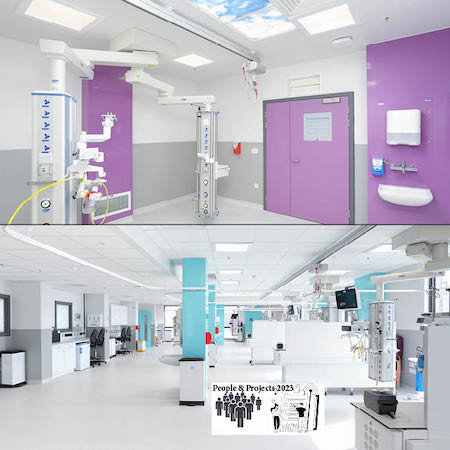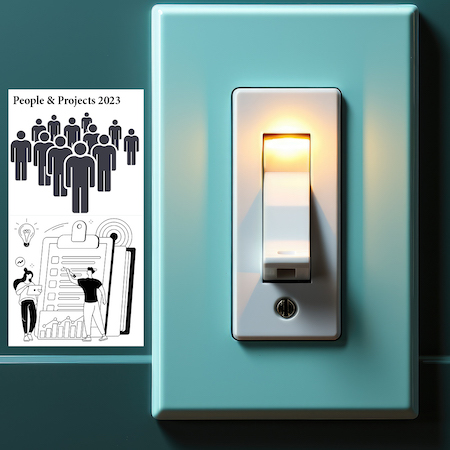A new, stand-alone, 48-bed Adult Intensive Care (AICU) and High Dependency Unit (HDU) opened in 2022 at the John Radcliffe Hospital (JR) in Oxford, after the Trust successfully bid for £24m funding from the £5.4bn announced by the Department of Health & Social Care in September 2020 to support the NHS in England through the pandemic. The complex, five-storey building took just 18 months to deliver – from initial design to handover – and was completed on budget.
The JR is a Major Trauma Centre, with a catchment area that covers Oxfordshire and the neighbouring counties of Berkshire and Buckinghamshire, although many patients come from much further afield. The former AICU and HDU had just 16 beds and occupied a subterranean unit located in a corner of a 1970s building. To respond to future pandemics, and a rapidly growing local population, the Trust needed a larger, custom-designed facility that would fit the needs of patients and provide a better and more supportive working environment for staff.
The new Oxford Critical Care (OCC) includes 10 isolation rooms and occupies 5,450sqm of space. Each of the first three storeys has ICU and HDU patient facilities. These can be easily re-zoned according to fluctuating demand, enabling efficient and flexible response to winter pressures, major incidents and future pandemics. Having ICU and HDU on the same floor benefits patients, allowing them to remain with familiar surroundings and staff as they move from one to the other. This continuity also improves conversations between clinicians and therapists, and with patients' families. For patients who are nearing end of life there are private single rooms in a quiet area on each floor with adjacent discussion rooms for difficult conversations with relatives. These facilities are decorated with carefully chosen colours and artworks.
The design of the patient care areas maximises natural light and views across the floor so staff feel connected at all times. Interior rooms with no natural light are fitted with large ceiling-mounted recessed lighting that projects images of the sky. This not only provides a more pleasant working environment, but giving patients a sense of day and night is also proven to be beneficial in their recovery and mental wellbeing.
A fully enclosed, glazed multidisciplinary team base at the centre of each floor means all clinical staff and therapists can see the adjacent beds and quickly react when a colleague needs help. Connectivity and communication in the wards have also been improved by special height Freeway Medical Custom Dividers between the beds. Staff can see into the rest of the ward over the dividers, but the patients’ beds are below the top, to maintain privacy when the curtains are drawn back. The dividers have colour-coded storage drawers that are uniform throughout the building so that medical supplies are provided in the same drawers in every bay or room.
The fourth floor of the OCC houses the plant room, staff changing and shower facilities, and a state-of-the-art pharmaceutical and medical supplies storeroom. The M&E equipment takes up approximately 80% of the space on this floor. The plant room services all clinical and non-clinical spaces, with 14 air handling units providing HTM-compliant ventilation at 16 air changes per hour, and enabling the ICU and HDU ‘halves’ of each clinical floor to be separately ventilated. Each of the 10 isolation rooms has its own air supply, and the ventilation system will enable air change rates, temperature and humidity to be adjusted for patients of different medical acuity. The pharmaceutical and medical supplies storeroom is staffed by two operatives who re-stock each bed every 24 hours with essential medical items, responding to urgent requests within a few minutes. This means that nurses never need to leave their patients’ bedsides to access stores. For staff, the locker and shower rooms feature hotel-quality lighting and finish.
A stunning fifth floor completes the new OCC. This is a quiet space, dedicated to study, learning and education, providing staff with a suitable space to carry out research, confer with colleagues and write papers. A social space is provided separately on the ground floor. This staff room has large windows and a zingy, citrus colour-scheme, which was chosen by the staff.
The build
Embarking on such a project during the height of the pandemic and in the immediate aftermath of Brexit meant time was of the essence. Decisions, once made, needed to be put into action before market conditions that could impact on the availability of materials, equipment and a consistent workforce shifted and disrupted progress. Enabling works started within a few weeks of the Trust receiving formal notice that its bid for funding had been successful, and a modular design was chosen for reasons of cost, speed, efficiency and flexibility. MTX was appointed as lead contractor due to the company’s experience in Modern Methods of Construction (MMC).
To reduce risk of delay, MTX, its contractors, the Trust’s project team and clinical staff (including the ‘behind the scenes’ teams such as clinical engineering, IT, finance & procurement and operational estates) worked together from the outset to make decisions and place orders quickly, whilst maintaining detailed scrutiny and monitoring to ensure best practice, cost control and governance. A local farmer's barn was rented to store materials and take deliveries so that supplies were immediately on hand when needed.
All of the 148 modules were manufactured off-site, delivered every three weeks to site on a low loader, and craned into the building module by module. Whilst the modules were being manufactured, work began to prepare the site. Piling was sunk to a depth of 20m and traditional foundations were laid to follow the site’s pronounced slope and natural contours. As the building is over three storeys high, Execution Class Three steel was sourced for the frame. This needs very precise welding and cutting to tolerances as low as 1mm, which was all done without a hitch. In keeping with the high-quality design, and the acuity of the patients, the concrete floors have a Response Factor of 1.
The module frames are a lightweight steel deck with a 20mm profile and 90mm self-levelling screed, which enabled contractors to move around inside the modules prior to the floors going in. Once the modules were safely placed, the concrete was poured floor by floor, and each module was fitted out with the required services, whilst the next set of modules was being manufactured.
The external terracotta cladding tiles are fixed to Rockwool insulated panels bonded to a base layer of Siniat 60-minute metal stud non-load-bearing plasterboard. The result is a U value exceeding that required in the Building Regulations Part L, and full fire safety compliance.
To ensure that the new OCC could be fully supported by Operational Estates’ Maintenance and Facilities teams after handover, the water, AV, heating and electrical teams were involved from the early stages of the build and given plenty of time for orientation and training before the unit was opened. The building has an innovative Pro Economy cold water return system for maintaining the cold-water supply below temperatures in which Legionella bacteria can grow. It also uses the same copper/silver solution that the hospital has across the rest of its retained estate’s water supply.
For electrical resilience, a new sub-station connected into the ring main and two transformers, backed up by a generator, were built in the adjacent car park. Inside the ICU there are ‘A’ and ‘B’ panels throughout, with all the electrical wiring coming down an A or B riser, and every medical pendant has dual circuits and dual sockets.
The pharmacy, portering, linen, cleaning and catering teams all had extensive training and orientation sessions well in advance of the opening to iron out any problems or anomalies before their services went live.
Clinical input
Lyn Bennett, an ICU matron with over 30 years’ experience, was seconded to the project team to give proactive input from the ICU team. In addition, two Intensive Care clinical leads - Dr Dave Garry and Dr Graham Barker - were heavily involved in the design and layout, on top of their day jobs, at a time when the pandemic was at its peak. None of these clinicians had a construction background, but their dedication to creating the best environment for staff and patients based on their years of hands-on Intensive Care experience was invaluable. They were the conduit for information and ideas between the project team and the ICU's clinical staff.
The ICU team got behind the planning of their new facility from the get-go. For example, to ensure that corridor widths, doors and lifts were the right size, Jody Ede, a Senior ICU Nurse and PhD student, led time and motion studies where she marked out the new floor plan on the floor of the hospital’s largest meeting room. Then key members of the ICU team used a mannequin in a bed to recreate moving a patient in an ICU bed around corners, in and out of the lift with all their medical gases, monitors, drips and three to four staff. This study helped the design team to ensure that the building did not have any corners, nooks or crannies that could impair moving patients at speed, and at the bedside that the Dräger pendants, monitors, and drugs, dressings and medical equipment are no more than an arm’s length away.
The project team also did regular updates for the ICU staff to show them their new building as it rose floor by floor. This was a real morale booster during a difficult time, and all the staff got involved, choosing colours and finishes, and making many helpful suggestions for small details that might otherwise have been overlooked.
Outcome
ICU is now in a custom-designed, light, bright building where staff and patients benefit from the perfect balance of calm, quiet, space, light, privacy and efficiency. Clinical staff have everything at the bedside to deliver the best care for their patients and can easily communicate with colleagues at all times of the day and night. The improved facilities for staff are having a positive impact on morale, and there is no doubt that this facility will also help with future staff recruitment and retention.
Charmaine Hope, Director of Estates, Facilities and Capital Development says: “The combination of the pandemic, Brexit, and supply chain shortages could have disrupted the project at any point, but the close collaboration and positive attitude of everyone involved ensured that problems were quickly resolved. I am proud of what we have all achieved in a very short time and in a very challenging working environment.”
Lyn Bennett adds: “It was a real learning curve for us clinicians to be involved in construction work, but we swapped our syringes for spanners and took to it like ducks to water! We have an outstanding team of highly motivated, talented, and dedicated staff in our ICU who deserve the best - and we really have delivered it. I couldn’t be prouder of what we have achieved.”
The Oxford Critical Care project was shortlisted for a HEFMA award this year. Nominations for the 2024 awards are now open. Click here to start your nomination for a team, individuals or projects at your Trust.










